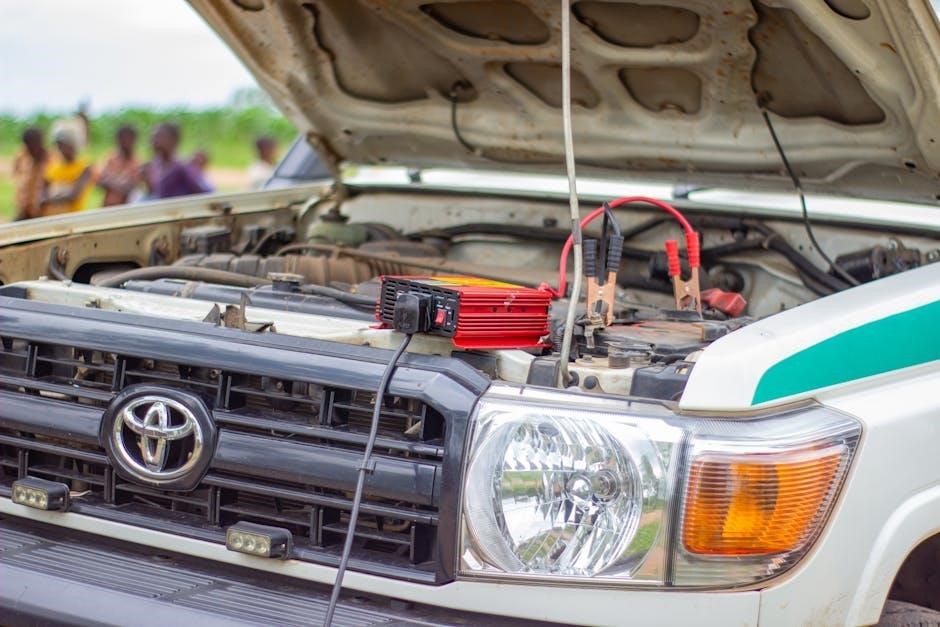The 2010 Toyota Prius Owners Manual provides comprehensive guidance for optimal vehicle operation and maintenance. Available online as a free PDF download, it covers all models and options, ensuring owners can explore features, understand specifications, and access warranty details. This essential resource helps drivers maximize efficiency and troubleshoot issues effectively.
Overview of the Manual
The 2010 Toyota Prius Owners Manual is a detailed guide designed to help owners understand and maintain their vehicle effectively. It covers all models, including the Prius 2010, 2011, and 2012, and explains various features, technical specifications, and maintenance requirements. The manual is available for free as a downloadable PDF, making it easily accessible. It includes sections on operation, troubleshooting, and safety features, ensuring drivers can optimize performance and address issues efficiently. Whether you’re a new or experienced owner, this manual is an essential resource for maximizing your Prius’s potential.
Importance of Reading the Manual
Reading the 2010 Toyota Prius Owners Manual is crucial for understanding your vehicle’s features, maintenance needs, and troubleshooting tips. It provides detailed insights into the hybrid system, fuel efficiency, and safety features, ensuring optimal performance. The manual also explains warranty details and technical specifications, helping you address issues promptly. By reviewing the guide, you can prevent potential problems, ensure proper vehicle care, and maximize your driving experience. It’s an essential resource for both new and experienced owners to get the most out of their Prius.
Interactive Manual Features
The 2010 Toyota Prius Owners Manual offers interactive features to enhance user experience. These include a searchable PDF format, hyperlinks for easy navigation, and interactive diagrams to explain complex systems. The manual also provides quick access to troubleshooting guides and maintenance schedules. With these features, owners can efficiently locate information, understand technical details, and resolve issues without flipping through pages. The interactive format ensures a user-friendly experience, making it easier to maximize the vehicle’s performance and longevity. This digital convenience is designed to support owners in every aspect of vehicle ownership.
Technical Specifications of the 2010 Toyota Prius

The 2010 Toyota Prius features a hybrid system, offering excellent fuel efficiency and reduced emissions. Its dimensions include a length of 182.9 inches, width of 69.4 inches, and height of 58.1 inches.
Engine and Hybrid System Details
The 2010 Toyota Prius features a 1.8-liter 4-cylinder gasoline engine combined with an electric motor, producing a total of 98 horsepower. The hybrid system seamlessly integrates both power sources, optimizing fuel efficiency and reducing emissions. The engine operates on the Atkinson cycle, enhancing efficiency, while the electric motor assists during acceleration and braking. This system allows the Prius to achieve excellent performance while maintaining low environmental impact, making it a leader in hybrid technology.
Fuel Efficiency and Performance
The 2010 Toyota Prius excels in fuel efficiency, offering an estimated 51 mpg in the city and 48 mpg on the highway. Its hybrid system combines a 1.8-liter engine with an electric motor, delivering smooth and efficient performance. The Atkinson-cycle engine enhances fuel economy, while the electric motor assists during acceleration, reducing emissions. With a combined 98 horsepower, the Prius balances efficiency with responsive driving, making it an ideal choice for eco-conscious drivers seeking both performance and environmental benefits.
Dimensions and Weight
- Length: 182.9 inches
- Width: 75.5 inches
- Height: 58.1 inches
- Wheelbase: 106.3 inches
- Curb Weight: Approximately 3,042 pounds

These measurements ensure a spacious interior while maintaining a lightweight design for optimal fuel efficiency and handling performance.

Maintenance and Repair Guidelines

Regular maintenance ensures optimal performance and longevity. Follow scheduled intervals, DIY tips, and repair recommendations to keep your 2010 Toyota Prius in top condition.
Scheduled Maintenance Intervals
The 2010 Toyota Prius manual outlines specific maintenance intervals to ensure optimal performance. Regular oil changes, tire rotations, and inspections are recommended at designated mileage markers. These schedules help prevent potential issues and ensure the hybrid system operates efficiently. Adhering to these intervals is crucial for maintaining fuel efficiency and overall vehicle health. The manual provides detailed timelines for services, ensuring owners can plan accordingly and keep their Prius in peak condition throughout its lifespan.
DIY Maintenance Tips
The 2010 Toyota Prius manual encourages owners to perform routine checks to maintain their vehicle’s health. Regularly inspecting tire pressure, oil levels, and air filters can enhance fuel efficiency and performance. DIY tasks like replacing the cabin air filter or checking brake pads are straightforward and cost-effective. The manual provides step-by-step guidance for these procedures, empowering owners to take an active role in maintaining their hybrid vehicle. This hands-on approach ensures optimal functionality and extends the lifespan of the Prius.
Repair Guidelines and Recommendations
The 2010 Toyota Prius manual outlines essential repair guidelines to ensure safety and efficiency. It recommends addressing issues promptly and using genuine Toyota parts for reliability. Software updates for braking systems and hybrid battery recalls are highlighted to maintain optimal performance. Owners are advised to consult the manual before attempting repairs and to seek professional assistance for complex tasks. Regular inspections and adherence to Toyota’s guidelines help prevent major repairs and ensure the vehicle operates at its best.
Troubleshooting Common Issues
The manual helps identify and resolve common issues like warning lights and braking system glitches. It guides owners on resetting the maintenance light and addressing hybrid battery recalls effectively.
Identifying Warning Lights
The 2010 Toyota Prius Owners Manual details how to identify and understand various warning lights on the dashboard. These include indicators for the hybrid system, anti-lock braking (ABS), and electronic stability control. The manual provides clear explanations of each light’s meaning, ensuring drivers can respond appropriately. For instance, it explains that a glowing ABS light may indicate a braking system issue, while a hybrid system light could signal a problem with the battery or engine. Timely action based on these warnings helps prevent potential damage and ensures safe driving conditions.
Common Problems and Solutions
The 2010 Toyota Prius Owners Manual addresses common issues, such as software updates for the braking system to fix glitches in the anti-lock braking (ABS) function. Hybrid battery performance concerns are also covered, with solutions like recalibrating or replacing the battery if necessary. Additionally, the manual provides guidance on resolving error lights related to the hybrid system, ensuring drivers can identify and address problems promptly to maintain vehicle efficiency and safety. Regular updates and maintenance are emphasized to prevent recurring issues.
Resetting the Maintenance Light
Resetting the maintenance light on your 2010 Toyota Prius is a straightforward process. Turn the ignition to the “ON” position without starting the engine. Use the steering wheel controls to navigate to the “TRIP” or “MAINTENANCE” menu on the instrument cluster. Select “RESET” and confirm the action. The light should turn off, indicating the system has been reset. If the light remains on, consult the manual or a professional for further diagnosis, as it may indicate an unresolved issue requiring attention.

Safety Features and Precautions
The 2010 Toyota Prius features advanced safety systems, including airbags, ABS, and electronic stability control. Always follow precautions outlined in the manual to ensure optimal safety and vehicle performance.
Understanding Airbag Systems
The 2010 Toyota Prius is equipped with a sophisticated airbag system designed to enhance passenger safety. Front airbags deploy during severe frontal collisions, while side and curtain airbags provide additional protection. The system is triggered by sensors that detect impact severity and location. Always wear seatbelts, as airbags are supplementary restraints. The manual emphasizes proper usage and precautions to avoid injuries. Note that airbag availability may vary depending on the vehicle model and configuration.
Anti-lock Braking System (ABS)
The 2010 Toyota Prius features an Anti-lock Braking System (ABS) designed to improve control during hard braking. ABS prevents wheel lock-up, reducing skidding and maintaining tire traction. Sensors monitor wheel speed, and the system rapidly pumps brakes if lock-up is detected. This enhances stability and shortens stopping distances. A software update was issued for the 2010 Prius to address ABS functionality, ensuring optimal performance. Always refer to the manual for proper system operation and troubleshooting guidelines.
Electronic Stability Control
The 2010 Toyota Prius is equipped with Electronic Stability Control (ESC), enhancing vehicle stability during cornering or slippery conditions. ESC automatically adjusts engine power and applies brakes to individual wheels to prevent skidding. This system works seamlessly with ABS to maintain traction and control. Drivers can rely on ESC to correct understeer or oversteer, improving overall safety. The manual provides details on how ESC operates and its role in maintaining stable driving dynamics. Proper functioning ensures a safer and more controlled driving experience.
Hybrid System and Fuel Efficiency
The 2010 Toyota Prius combines a gasoline engine and electric motor for optimal fuel efficiency. Its hybrid system seamlessly transitions between power sources, maximizing energy use and minimizing consumption.
How the Hybrid System Works
The 2010 Toyota Prius hybrid system integrates a 1.8L gasoline engine and an electric motor, working together to optimize fuel efficiency and reduce emissions. The system automatically switches between the engine and motor, or uses both, depending on driving conditions. Regenerative braking captures kinetic energy to recharge the hybrid battery, enhancing efficiency. This seamless operation ensures smooth power delivery while minimizing environmental impact, making the Prius a leader in eco-friendly transportation technology.
Maximizing Fuel Efficiency
To maximize fuel efficiency in your 2010 Toyota Prius, drive smoothly and maintain consistent speeds. Avoid sudden acceleration and braking, as this reduces efficiency. Use the Eco-Mode for optimal performance in city driving. Ensure proper tire pressure, as under-inflated tires can lower fuel efficiency. Regularly maintain the hybrid system and battery to ensure peak performance. Additionally, remove extra weight from the vehicle and plan routes to minimize traffic and idling time. These practices help achieve the best possible mileage and reduce environmental impact.
Monitoring Fuel Consumption
The 2010 Toyota Prius Owners Manual provides detailed guidance on monitoring fuel consumption. Use the multi-information display to track real-time fuel efficiency and trip meters for distance and fuel used. The manual explains how to interpret these readings to optimize driving habits. Regularly reviewing fuel consumption data helps identify trends and areas for improvement. Understanding these tools ensures you maximize the hybrid system’s efficiency and maintain optimal performance over time.

Warranty Information
The 2010 Toyota Prius Owners Manual details warranties for new vehicles, accessories, and hybrid batteries. It outlines coverage periods, conditions, and exclusions, ensuring owners understand their protections and benefits.
New Vehicle Warranty Details
The 2010 Toyota Prius Owners Manual outlines the new vehicle warranty, covering repairs for parts and labor during the initial 3 years or 36,000 miles. The powertrain warranty extends to 5 years or 60,000 miles, ensuring long-term protection. Additionally, the hybrid battery is covered for 8 years or 100,000 miles, reflecting Toyota’s confidence in its durability. The manual explains warranty conditions, exclusions, and transferability, helping owners understand their coverage and maintain their vehicle effectively.
Hybrid Battery Warranty
The 2010 Toyota Prius Owners Manual details the hybrid battery warranty, which covers the battery for 8 years or 100,000 miles, whichever comes first. This warranty ensures repair or replacement if the battery fails to meet specified performance levels. It reflects Toyota’s confidence in the hybrid system’s reliability and durability. The manual outlines conditions for warranty coverage and notes that the warranty is transferable to subsequent owners, enhancing the vehicle’s resale value and providing long-term peace of mind for drivers.
Accessories Warranty Coverage
The 2010 Toyota Prius Owners Manual outlines the accessories warranty, which covers genuine Toyota accessories installed at the time of purchase. This warranty provides protection for parts like audio systems, navigation, and other factory-approved components. Coverage typically lasts for 3 years or 36,000 miles, ensuring reliability and performance. The manual emphasizes that accessories must be approved by Toyota to qualify for warranty coverage, offering owners peace of mind and protection against defects in materials and workmanship.

User Manual Specifics
The 2010 Toyota Prius Owners Manual is available online as a free PDF download, covering all models and explaining various equipment, including optional features not installed on every vehicle.
How to Read the Manual
Reading the 2010 Toyota Prius Owners Manual is straightforward. Start with the table of contents to navigate sections like technical specifications, maintenance, and troubleshooting. Use the index for quick access to specific topics. Pay attention to symbols and terminology explained in the manual for clarity. Review warranty details and update information for the latest recalls. Regularly check for software updates and maintenance schedules to ensure optimal performance. Understanding the manual helps owners maximize efficiency and address issues promptly.
Downloading the PDF Version
The 2010 Toyota Prius Owners Manual is available for free download as a PDF. Visit the official Toyota website or trusted automotive resources to access the file. Ensure your device has a PDF reader installed for viewing. The manual covers all models, including Prius 2010, 2011, and 2012. Downloading the PDF allows easy access to maintenance schedules, troubleshooting guides, and warranty details. Regularly check for updates to ensure you have the latest version with the most accurate information.
Understanding Symbols and Terminology
The 2010 Toyota Prius Owners Manual uses specific symbols and terminology to convey important information. Familiarize yourself with these symbols, such as warning icons for maintenance or system alerts, to ensure safe and proper vehicle operation. The manual explains technical terms and abbreviations, making it easier to understand instructions. While some explanations may cover optional features not installed on your vehicle, the guide remains comprehensive for all models, including Prius 2010, 2011, and 2012. This clarity helps owners interpret and act on the information effectively.

Tires and Wheels
The 2010 Toyota Prius manual emphasizes proper tire pressure, regular wheel inspections, and correct tire replacement procedures. Adhering to these guidelines ensures safety and optimal fuel efficiency.
Recommended Tire Pressure
The 2010 Toyota Prius manual specifies the recommended tire pressure to ensure optimal performance and safety. For normal driving conditions, the front tires should be inflated to 35 PSI, and the rear tires to 33 PSI. When the vehicle is fully loaded, the pressure increases to 38 PSI for both front and rear tires. It is crucial to check tire pressure monthly and before long trips, as under-inflation can reduce fuel efficiency and cause uneven tire wear. Always refer to the tire information placard on the driver’s doorjamb or inside the fuel filler door for accurate specifications.
Wheel Maintenance Tips
Regular wheel maintenance is essential for the 2010 Toyota Prius. Clean wheels regularly to prevent brake dust buildup, which can damage finishes. Inspect for cracks or damage and tighten lug nuts properly after tire changes. Avoid using harsh chemicals, as they may harm wheel coatings. Rotate tires every 5,000 to 8,000 miles to ensure even wear. Check wheel alignment annually to improve handling and prevent uneven tire wear. Proper maintenance ensures safety, enhances appearance, and prolongs wheel longevity.
Replacing Tires
When replacing tires on your 2010 Toyota Prius, always refer to the owner’s manual for specific instructions. Ensure the spare tire is in good condition and properly inflated. Loosen lug nuts with the vehicle on the ground before jacking. Remove the flat tire and replace it with the spare, then tighten lug nuts in a star pattern. Lower the vehicle and tighten lug nuts again to the recommended torque. Always use tires of the same size and type as specified in the manual for optimal performance and safety.
Recall Notices and Updates
The 2010 Toyota Prius recall addresses software updates for the braking system to fix anti-lock braking glitches. Owners should check for updates and follow instructions provided by Toyota.
Software Updates for Braking Systems

The 2010 Toyota Prius recall includes software updates for the braking system to address anti-lock braking glitches. This update improves braking performance and ensures safety. Owners are advised to check for updates through Toyota’s official channels and follow the provided instructions. The software update is free and performed by certified Toyota technicians to maintain vehicle safety and performance. Regular checks for updates are crucial to keep the braking system functioning optimally and prevent potential issues.
Hybrid Battery Recall Information
The 2010 Toyota Prius hybrid battery recall addresses potential issues with the hybrid system. Toyota has issued recalls for certain models to ensure battery reliability and performance. Owners are encouraged to check if their vehicle is affected by contacting Toyota directly or using the official recall lookup tool. The recall process is free and aims to maintain the hybrid system’s efficiency and safety. Regular updates and checks are recommended to ensure the battery operates within optimal parameters and meets Toyota’s quality standards.
How to Check for Recalls
To check for recalls on your 2010 Toyota Prius, visit Toyota’s official website and use their recall lookup tool. Enter your Vehicle Identification Number (VIN) to see if your car is affected by any ongoing recalls. Additionally, contact your local Toyota dealership or customer service for assistance. Regularly checking for recalls ensures your vehicle remains safe and up-to-date with necessary repairs or updates, all of which are provided free of charge by Toyota.
